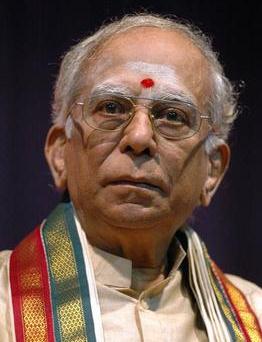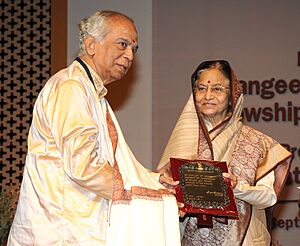Lalgudi Jayaraman facts for kids
Quick facts for kids
Lalgudi Jayaraman
|
|
|---|---|
 |
|
| Background information | |
| Born | 17 September 1930 Edayathumangalam, Trichinopoly District (now a part of Lalgudi taluk, Tiruchirappalli district), British India |
| Died | 22 April 2013 (aged 82) Chennai, Tamil Nadu, India |
| Genres | Indian classical music |
| Occupation(s) | Violinist, composer, |
| Instruments | Violin, percussion, synthesizers |
| Years active | 1942–2013 |
Lalgudi Gopala Jayaraman (born September 17, 1930 – died April 22, 2013) was a famous Indian Carnatic violinist, singer, and composer. Carnatic music is a type of classical music from South India. He is often seen as one of the three greatest Carnatic violinists, along with M.S. Gopalakrishnan and T.N.Krishnan.
Lalgudi Jayaraman was honored with the Padma Bhushan award by the Government of India in 2001. This is one of India's highest civilian awards. Many students learned music from him, including his children, Lalgudi G. J. R. Krishnan and Lalgudi Vijayalakshmi.
Contents
Early Life and Musical Training
Lalgudi Jayaraman came from a family with a strong musical background. His family was connected to the great "musical trinity" of Carnatic music: Musthuswamy Dikshitar, Shyama Shastri, and St. Thyagaraja. He learned music from his father, V. R. Gopala Iyer.
His father was a strict teacher who made sure young Jayaraman focused intensely and practiced with great discipline. Even though his father was tough, he also cared deeply for Jayaraman's hands, believing they were too important for playing the violin.
A Career in Music
Lalgudi Jayaraman began his music journey at just 12 years old. He started by playing the violin for other Carnatic musicians. Soon, he became a well-known solo performer.
He created a new way of playing the violin that suited Indian Classical Music. This unique style became known as the Lalgudi Bani. Jayaraman also wrote many musical pieces, including 'kritis', 'tillanas', and 'varnams'. These pieces beautifully combined melody, emotion, rhythm, and lyrics.
Lalgudi Jayaraman was very good at making the violin sound like it was singing. He understood the words of the songs he played, which made his performances special. He also carefully reviewed his own concerts, a habit his father encouraged. He preferred to plan his solo concerts in detail, but his natural talent often shone through when he played with other singers.
He was very popular as an accompanying violinist and played with many famous singers like M.Balamuralikrishna and T. N. Seshagopalan. He kept a promise to his father not to play with female artists. Lalgudi Jayaraman performed widely in India and other countries. The Government of India even sent him to Russia as part of an Indian Cultural group.
He was the first musician to bring international attention to the Carnatic style of violin playing. In 1966, he also started a new type of musical group that included the violin, venu (flute), and veena.
In 1965, the famous violinist Yehudi Menuhin invited him to play at the Edinburgh Festival. Menuhin was so impressed by Lalgudi's playing that he gave him his own Italian violin. Lalgudi Jayaraman later gave Menuhin an ivory dancing Nataraja statue when Menuhin visited India.
He performed in many countries, including Singapore, Malaysia, and European nations. His recordings were even chosen as the best among 77 entries from different countries in 1979 by the International Music Council. He also composed a musical ballet called Jaya Jaya Devi, which was first performed in the United States in 1994.
His life story, titled An Incurable Romantic, was published after his death in 2013.
Awards and Honors
Lalgudi Jayaraman received many awards and titles throughout his career:
- 'Nada Vidya Tilaka' in 1963.
- 'Padma Shri' by the Government of India in 1972. This is a high civilian award.
- 'Sangeetha Choodamani' in 1971.
- The Sangeet Natak Akademi Award in 1979.
- He received honorary citizenship of Maryland, USA, in 1994.
- The Padma Bhushan by the Government of India in 2001. This is an even higher civilian award.
- He won the National Film Award for Best Music Direction for the film Sringaram in 2006.
- In 2010, he became a fellow of the Sangeet Natak Akademi, which is a great honor for artists.
Personal Life
Lalgudi Jayaraman was married to Smt Rajalakshmi. They had two children, a son named G.J.R.Krishnan and a daughter named Lalgudi Vijayalakshmi. Both of his children followed in his footsteps and became famous musicians themselves.
He also had three sisters: Padmavathy, Rajalakshmi, and Srimathi. Srimathi also learned to play the violin from him. The well-known veena player Jayanthi Kumaresh is his niece.
Lalgudi Jayaraman passed away on April 22, 2013, at his home in Chennai after a heart attack.
Musical Compositions
Lalgudi Jayaraman is known as one of the most creative composers of modern times. He is especially famous for his 'thillanas' and 'varnams'.
His compositions are written in four languages: Tamil, Telugu, Kannada, and Sanskrit. He used many different ragas (melodic frameworks) that were not commonly used for these types of pieces. His music often sounds simple and beautiful, but it actually has complex rhythms hidden within. His compositions are very popular with Bharathanatyam dancers and are often performed by leading Carnatic musicians.
Some of his famous compositions include:
Varnams
| Composition | Raga | Language |
|---|---|---|
| Chalamu séyanéla | Valaji | Telugu |
| Parama karuna | Garudadhvani | Telugu |
| Vallabhai nayaka | Mohanakalyani | Tamil |
| Devi un paadamé | Devagandhari | Tamil |
| Unnai yandri | Kalyani | Tamil |
| Tarunam En Taye | Saama | Tamil |
Thillanas
|
|
Lalgudi Jayaraman also arranged the famous Swathi Thirunal thillana 'Gitu Dhunika Taka Dhim' in Raga Dhanashree.
Krithis
| Krithi | Raga | Language |
|---|---|---|
| Vinayakunnadeva | Dharmavati | Telugu |
| Kandan Seyalandro | Nattakurinji | Tamil |
| Kumara Guruguham | Shanmukhapriya | Sanskrit |
| Nee Dayai Seyyavidil | Begada | Tamil |
Besides these, Lalgudi Jayaraman also composed 'jathiswarams' and 'swarajathis'. His 'jathiswaram' in Rasikapriya raga is very popular among Bharatanatyam dancers. He also created a special 'swarajathi' that shows the concept of Graha bhedam, using ragas like Sindhu Bhairavi and Mohanakalyani. He was also a sought-after composer who set music to many songs, including those by Ambujam Krishna.


